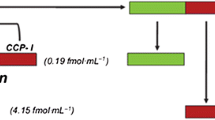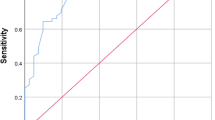Abstract
The pathogenesis of necrotizing enterocolitis (NEC) remains poorly understood. We aimed to assess the extent of bacterial infection in the pathogenesis of NEC using serial procalcitonin measurements. Blood samples were drawn during the first 4 days following every clinical event requiring a workup for presumed NEC. Eight episodes were confirmed as NEC, 7 of which showed procalcitonin levels <1 ng/ml at presentation and <1.3 ng/ml thereafter, comparable to 24 healthy controls. The one infant with elevated procalcitonin had bacteremia in addition to NEC. Procalcitonin levels of 24 matched septic infants were higher than those of NEC infants, peaking at 4.1 ng/ml. We conclude that low procalcitonin values are the rule during episodes of NEC and provide further evidence that overactive local immune response, and not active infection, is primarily responsible for the mucosal damage in NEC.
Similar content being viewed by others
References
Tudehope DI (2005) The epidemiology and pathogenesis of neonatal necrotizing enterocolitis. J Paediatr Child Health 41:167–168
Chan KL, Ng SP, Chan KW, Wo YH, Tam PK (2003) Pathogenesis of neonatal necrotizing enterocolitis: a study of the role of intraluminal pressure, age and bacterial concentration. Pediatr Surg Int 19:573–577
Yost CC (2005) Neonatal necrotizing enterocolitis: diagnosis, management, and pathogenesis. J Infus Nurs 28:130–134
Luig M, Lui K (2005) Epidemiology of necrotizing enterocolitis. Part II: Risks and susceptibility of premature infants during the surfactant era: a regional study. J Paediatr Child Health 41:174–179
Kliegman RM (2005) Oral probiotics reduce the incidence and severity of necrotizing enterocolitis in very low birth weight infants. J Pediatr 146:710
Santulli TV, Schullinger JN, Heird WC, Gongaware RD, Wigger J, Barlow B, Blanc WA, Berdon WE (1975) Acute necrotizing enterocolitis in infancy: a review of 64 cases. Pediatrics 55:376–387
Lawrence G, Bates J, Gaul A (1982) Pathogenesis of neonatal necrotising enterocolitis. Lancet 1:137–139
Hsueh W, Caplan MS, Qu XW, Tan XD, De Plaen IG, Gonzalez-Crussi F (2003) Neonatal necrotizing enterocolitis: clinical considerations and pathogenetic concepts. Pediatr Dev Pathol 6:6–23
de la Cochetiere MF, Piloquet H, des Robert C, Darmaun D, Galmiche JP, Roze JC (2004) Early intestinal bacterial colonization and necrotizing enterocolitis in premature infants: the putative role of Clostridium. Pediatr Res 56:366–370
Hackam DJ, Upperman JS, Grishin A, Ford HR (2005) Disordered enterocyte signaling and intestinal barrier dysfunction in the pathogenesis of necrotizing enterocolitis. Semin Pediatr Surg 14:49–57
van Rossum AM, Wulkan RW, Oudesluys-Murphy AM (2004) Procalcitonin as an early marker of infection in neonates and children. Lancet Infect Dis 4:620–630
Pecile P, Miorin E, Romanello C, Falleti E, Valent F, Giacomuzzi F, Tenore A (2004) Procalcitonin: a marker of severity of acute pyelonephritis among children. Pediatrics 114:e249–e254
Meisner M SJ, Hüttner H, Tschaikowsky K (2004) The natural elimination rate of procalcitonin in patients with normal and impaired renal function. Intensive Care Med 26:P212–P216
Turner D, Hammerman C, Rudensky B, Schlesinger Y, Schimmel MS (2006) The role of procalcitonin as a predictor of nosocomial sepsis in preterm infants. Acta Paediatr 95(12):1571--1576.
Duffy LC, Zielezny MA, Carrion V, Griffiths E, Dryja D, Hilty M, Rook C, Morin F 3rd (1997) Concordance of bacterial cultures with endotoxin and interleukin-6 in necrotizing enterocolitis. Dig Dis Sci 42:359–365
Harris MC, Costarino AT Jr, Sullivan JS, Dulkerian S, McCawley L, Corcoran L, Butler S, Kilpatrick L (1994) Cytokine elevations in critically ill infants with sepsis and necrotizing enterocolitis. J Pediatr 124:105–111
Grotz MR, Deitch EA, Ding J, Xu D, Huang Q, Regel G (1999) Intestinal cytokine response after gut ischemia: role of gut barrier failure. Ann Surg 229:478–486
Ford H, Watkins S, Reblock K, Rowe M (1997) The role of inflammatory cytokines and nitric oxide in the pathogenesis of necrotizing enterocolitis. J Pediatr Surg 32:275–282
Turner D, Hammerman C, Rudensky B, Schlesinger Y, Goia C, Schimmel MS (2006) Procalcitonin in preterm infants during the first few days of life: introducing an age related nomogram. Arch Dis Child Fetal Neonatal Ed 91:F283–F286
Bell MJ, Ternberg JL, Feigin RD, Keating JP, Marshall R, Barton L, Brotherton T (1978) Neonatal necrotizing enterocolitis. Therapeutic decisions based upon clinical staging. Ann Surg 187:1–7
Chiesa C, Panero A, Rossi N, Stegagno M, De Giusti M, Osborn JF, Pacifico L (1998) Reliability of procalcitonin concentrations for the diagnosis of sepsis in critically ill neonates. Clin Infect Dis 26:664–672
Martin CR, Walker WA (2006) Intestinal immune defences and the inflammatory response in necrotising enterocolitis. Semin Fetal Neonatal Med 11:369–377
Bury RG, Tudehope D (2001) Enteral antibiotics for preventing necrotizing enterocolitis in low birthweight or preterm infants. Cochrane Database Syst Rev CD000405
Bin-Nun A, Bromiker R, Wilschanski M, Kaplan M, Rudensky B, Caplan M, Hammerman C (2005) Oral probiotics prevent necrotizing enterocolitis in very low birth weight neonates. J Pediatr 147:192–196
Lin HC, Su BH, Chen AC, Lin TW, Tsai CH, Yeh TF, Oh W (2005) Oral probiotics reduce the incidence and severity of necrotizing enterocolitis in very low birth weight infants. Pediatrics 115:1–4
Ballance WA, Dahms BB, Shenker N, Kliegman RM (1990) Pathology of neonatal necrotizing enterocolitis: a ten-year experience. J Pediatr 117:S6–S13
Sun XM, MacKendrick W, Tien J, Huang W, Caplan MS, Hsueh W (1995) Endogenous bacterial toxins are required for the injurious action of platelet-activating factor in rats. Gastroenterology 109:83–88
Lee JS, Polin RA (2003) Treatment and prevention of necrotizing enterocolitis. Semin Neonatol 8:449–459
Claud EC, Walker WA (2001) Hypothesis: inappropriate colonization of the premature intestine can cause neonatal necrotizing enterocolitis. FASEB J 15:1398–1403
Israel EJ (1994) Neonatal necrotizing enterocolitis, a disease of the immature intestinal mucosal barrier. Acta Paediatr Suppl 396:27–32
Bush TG (2002) Enteric glial cells. An upstream target for induction of necrotizing enterocolitis and Crohn's disease? Bioessays 24:130–140
Habib Z, Arnaud B, Pascal de L, Caroline F, Yves A, Jean-Pierre C, Michel P, Jean-Pierre H, Dominique B (2005) CARD15/NOD2 is not a predisposing factor for necrotizing enterocolitis. Dig Dis Sci 50:1684–1687
Szebeni B, Szekeres R, Rusai K, Vannay A, Veres G, Treszl A, Arato A, Tulassay T, Vasarhelyi B (2006) Genetic polymorphisms of CD14, Toll-like receptor 4, and caspase-recruitment domain 15 are not associated with necrotizing enterocolitis in very low birth weight infants. J Pediatr Gastroenterol Nutr 42:27–31
Neu J, Chen M, Beierle E (2005) Intestinal innate immunity: How does it relate to the pathogenesis of necrotizing enterocolitis. Semin Pediatr Surg 14:137–144
Warner BW, Warner BB (2005) Role of epidermal growth factor in the pathogenesis of neonatal necrotizing enterocolitis. Semin Pediatr Surg 14:175–180
Caplan MS, MacKendrick W (1994) Inflammatory mediators and intestinal injury. Clin Perinatol 21:235–246
Caplan MS, Sun XM, Hseuh W, Hageman JR (1990) Role of platelet activating factor and tumor necrosis factor-alpha in neonatal necrotizing enterocolitis. J Pediatr 116:960–964
Acknowledgments
BRAHMS Diagnostica provided the testing kits for PCT determination but was not involved in any part of the study design, data collection, data analysis, or manuscript preparation. The authors wish to thank the nurses of NICU who meticulously collected the blood samples.
Author information
Authors and Affiliations
Corresponding author
Rights and permissions
About this article
Cite this article
Turner, D., Hammerman, C., Rudensky, B. et al. Low Levels of Procalcitonin During Episodes of Necrotizing Enterocolitis. Dig Dis Sci 52, 2972–2976 (2007). https://doi.org/10.1007/s10620-007-9763-y
Received:
Accepted:
Published:
Issue Date:
DOI: https://doi.org/10.1007/s10620-007-9763-y




